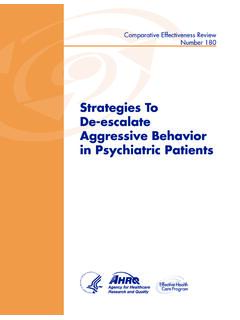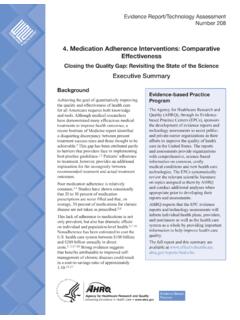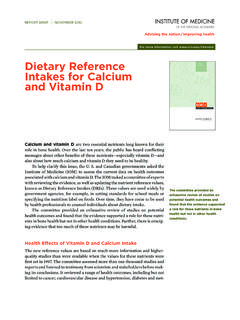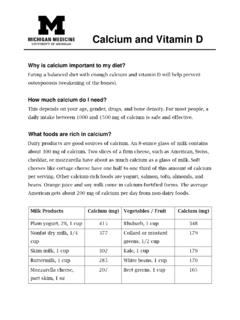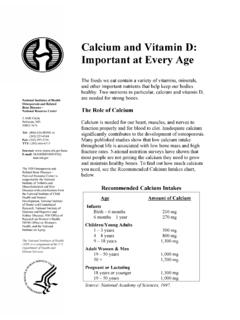Transcription of Evidence-based Practice Center Systematic Review Protocol ...
1 Source: Published online: June 10, 2013 1 Evidence-based Practice Center Systematic Review Protocol Project Title: vitamin D and calcium : A Systematic Review of Health Outcomes I. Background and Objectives for the Systematic Review The Institute of Medicine (IOM) establishes Dietary Reference Intakes (DRIs), nutrient reference values based on current knowledge about the roles of the various nutrients in human health. The DRIs which comprise estimated average requirements (EARs), adequate intakes (AIs; set in the absence of sufficient evidence to set an EAR), and upper limits (ULs; the highest level of intake likely to pose no health risk to most individuals) form the basis of dietary guidance for the United States and Canada.
2 The first DRI report, released in 1997, based the recommended levels of vitamin D and calcium on the role of these nutrients in bone In 2009, based in part on increasing interest in the potential roles of calcium and vitamin D in preventing chronic disease (beyond their roles in preventing acute deficiency states) and physicians increasing use of laboratory tests to assess vitamin D and calcium status among patients, the and Canadian governments requested that the IOM Review the literature assessing the potential role of these nutrients in human health outcomes. The Committee to Review Dietary Reference Intakes for vitamin D and calcium commissioned the Agency for Healthcare Research and Quality (AHRQ)
3 To conduct a Systematic Review , the results of which would form part of the basis for the update to the 1997 DRIs The IOM report noted the lack of strong evidence for an association of vitamin D and calcium status with conditions other than bone health and the need to continue relying on the latter as a basis for making recommendations reflecting, in part, the challenges associated with assessing the role of nutrients in the etiology of chronic diseases and using such outcomes in setting recommendations for optimal Research aimed at identifying vitamin D and calcium intakes associated with increased or decreased health risks present several unique challenges. Unlike that of other nutrients, vitamin D status reflects not only dietary intake but also synthesis in response to sun exposure.
4 Further, assessing vitamin D intake is hampered by changing or insufficient information on fortification and food Thus, at present, assessment of serum vitamin D levels appears to provide the closest reflection of physiological status. However, the results of the various serum assays are not strictly comparable with each other or with historical ,6 Evidence suggests current laboratory reference ranges may be too high,7 which would result in too many individuals being wrongly diagnosed as having vitamin D deficiency. Further, health outcomes that depend on vitamin D may not strictly reflect vitamin D status, in part because of the strong interdependence between vitamin D and calcium and because many vitamin D trials also administer calcium .
5 In preparation for a project the Office of Dietary Supplements (ODS) at the National Institutes of Health is undertaking on best clinical practices related to vitamin D in primary care settings, based on the updated DRI report, the ODS and AHRQ requested an update to the 2009 Systematic Review that will incorporate the findings of studies on vitamin D and vitamin D Source: Published online: June 10, 2013 2 administered in conjunction with calcium that have been conducted since the release of that Review . The update report will assess all outcomes assessed in the original 2009 report with the exception of weight and growth. The update report will also stratify the findings of the previous Review , as well as any newly included studies on efficacy and adverse events according to vitamin D serum assay methodology, to permit a comparison by assay method.
6 II. The Key Questions Introduction The Key Questions (KQs) that will drive the update Review are identical to those that drove the original 2009 Review , with several minor exceptions mandated by the sponsors. These exceptions were described above and are indicated below in the text of the KQs themselves. The PICOTS (population, intervention, comparator, outcomes, timing and setting) are also given for each KQ. Key Question 1 What is the effect of vitamin D intake or combined vitamin D plus calcium intake (but not calcium intake alone) on clinical outcomes, including cardiovascular diseases, cancer, immune function, pregnancy or birth outcomes, mortality, fracture, renal outcomes, and soft tissue calcification (the current report excludes two outcomes included in the original 2009 report:growth and weight management).
7 Population(s) o The primary population of interest is generally healthy people with no known disorders, with the following exceptions. Studies that include broad populations might include some individuals with diseases or who are at risk for diseases. o Studies of individuals with previous cancer, previous fractures, or precancerous conditions will be included. o With the exception of studies of older adults, studies in which more than 20 percent of the participants have been diagnosed with a disease will be excluded. o For clinical outcomes of cardiovascular disease (CVD), only studies of adults will be included ( 18 years of age) Interventions o For observational studies (exposures): Serum concentration of 25-hydroxyvitamin D [25(OH)D] or 1,25-dihydroxyvitamin D [1,25(OH)2D] and method used Dietary intake of calcium from food and supplements calcium balance o For interventional studies: Source: Published online.
8 June 10, 2013 3 vitamin D supplements with known doses calcium supplements if coadministered with vitamin D Food-based interventions in which the doses of vitamin D and calcium were quantified and in which the doses differ between comparison groups Comparators o For observational studies: Lower serum concentrations of vitamin D o For interventional studies: Placebo, nonfortified/supplemented food Outcomes o CVD clinical outcomes Cardiac events or symptoms Cerebrovascular events Peripheral vascular events or symptoms Cardiovascular death Study-specific combinations of cardiovascular events o Cancer (incident or mortality) Total cancer Prostate cancer Colorectal cancer Breast cancer Pancreatic cancer Cancer-specific mortality o Immune function clinical outcomes Infectious disease Autoimmune diseases Infectious disease-specific mortality o Pregnancy-related outcomes Preterm birth or low birth weight Infant mortality o Mortality, all cause o Bone health, clinical outcomes Rickets Fracture Falls or muscle strength Source: Published online.
9 June 10, 2013 4 o Adverse effects of intervention(s) All-cause mortality Cancer and cancer-specific mortality Renal outcomes Soft tissue calcification (Other) adverse events from vitamin D or vitamin D plus calcium supplements Timing o Timing of interventions or exposures will not be prespecified, with the exception that cross-sectional and retrospective case-control studies will not be included (nested case controls within prospective cohort studies will be included). o For studies with multiple followup periods, the longest followup times will be preferentially considered. Settings o Settings will not be prespecified. Key Question 2 What is the effect of vitamin D or combined vitamin D and calcium intake on surrogate or intermediate outcomes, such as hypertension, blood pressure, and bone mineral density?
10 Populations o As described for KQ 1, with the exception that for blood pressure and other CVD intermediate outcomes, only studies of adults 18 years of age will be included. Interventions o As described for KQ 1, with the following exceptions: For CVD outcomes, only randomized controlled trials (RCTs) will be included. For bone health outcomes, only RCTs of greater than 1 year in duration will be included. Comparators o As described for KQ 1. Outcomes As specified in the original 2009 report, unless otherwise noted: CVD intermediate outcomes Cancer intermediate outcomes (colorectal adenoma, aberrant crypt cells, and mammographic breast density) Bone health intermediate outcomes (only bone mineral density/content) Source: Published online: June 10, 2013 5 Pregnancy-related intermediate outcomes Pre-eclampsia High blood pressure with or without proteinuria Timing o As described for KQ 1, except for intermediate bone health for which studies of less than 1 year in duration will be excluded.






